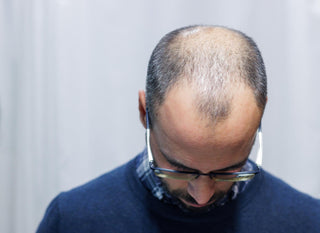Decode the mystery behind grey hair and explore the fascinating science behind its causes, including genetic influences, the role of oxidative stress, melanin and NAD+ in this in-depth article.
Have you ever pulled out a silver strand of hair from your scalp, stared at it incredulously, and wondered – What the heck, why? Well, don't worry, you're not alone.
The journey of greying hair is an essential chapter in the book of life that everyone starts to read at some point, willingly or not. But, what if we told you there's a captivating tale of science and biology behind those salt-and-pepper locks?
Today, we're pulling back the curtain on the enigma called 'grey hair,' shedding light on its causes, the genetic factors at play, the intricate role of oxidative stress and melanin, and even a dash of NAD+ thrown into the mix.
Why does hair turn grey?
"Old age," you might utter instantly. While that's not untrue, the story's far from over.
A colour-coded substance known as melanin, produced by cells named melanocytes, is the chief architect behind the natural pigment in your hair. [1]
Simple enough, right?
But here's where oxidative stress walks in, causing a gradual decrease in melanin, thus paving the way for grey hair [2].
And, genetics you ask? Well, it's like your family's favourite recipe passed down through generations but with a twist. If your parents started greying early on, you probably will too [3].
The melanin and the grey hair connection
Peppy or dark haired one day, and salt-and-pepper the next. This transformation is exquisite, complex, and yes, completely natural. So, what's with melanin’s connection to grey hair?
The role of melanin
Melanin, primarily responsible for the colour of your hair, comes in two types, eumelanin (brown or black) and pheomelanin (yellow or red). Your unique blend of these two creates your distinct hair colour.
Now, as you age, your hair follicles start producing less melanin, leading to a loss of hair colour and causing the hair to turn silver, grey, or white [4].
The genetics of greying hair
Turns out, you can blame your genes, rather than your office stress, for your hair turning grey.
While environmental factors subtly contribute to hair greying, research has found that the primary influencer of when and how you grey is written in your DNA[5].
Oxidative stress: The arch-nemesis of coloured hair
Feel like your hair is waving the white flag prematurely? It might be oxidative stress in play.
The human body naturally creates free radicals, rogue agents causing oxidative stress, as a byproduct of turning food into energy [6].
With age, and increase in these free radicals and a decrease in the body's ability to fight them off can lead to your hair colour 'packing its bags and bidding adieu,' causing what we commonly term as greying [7].
The intriguing role of NAD+
What's NAD+, and what it’s got to do with hair greying, you may ask?
Nicotinamide adenine dinucleotide (NAD+) is a coenzyme found in all living cells, including the ones in your hair follicles.
It's directly involved with the production of energy and the maintenance of DNA health.
It's hypothesized that a decrease in NAD+ with age might influence mitochondrial function, causing a lack in melanocyte stem cell function, thus leading to the greying process [8].
Which NAD+ ….
Embracing the grey
Grey hair is a testament to each year lived, each story spun, each challenge conquered.
Embrace your silver mane. It's a part of you, your journey, your story. After all, grey is simply the new black!
FAQs
1. Is there a way to reverse greying?
Despite several advances, there's no reliable way to reverse greying yet. However, ensuring good nutritional balance and leading a less stressful life may delay it [9].
2. Is early greying a sign of any health disorders?
Early greying may sometimes be a sign of certain health conditions, such as vitiligo or thyroid disorders. Whenever in doubt, consult a medical professional [10].
Conclusion
In the grand tapestry of life, grey threads are as essential as any other.
The science of grey hair is a blend of genetics, biology, oxidative stress, and even the levels of NAD+ in our bodies.
While our tryst with grey hair might seem daunting at first, understanding the science behind it allows us to accept and embrace this natural phase in our lives.
After all, each silver strand has a tale to tell.
References
- Paus, R., et al. (2011) 'The biology of hair pigment'. Dermatology Review.
- Arck, P., et al. (2006) 'Towards a "free radical theory of greying"'. Journal of Cosmetic Dermatology.
- Adhikari, K., et al. (2016) 'A genome-wide association scan in admixed Latin Americans identifies loci influencing facial and scalp hair features'. Nature Communications.
- Sturm, R.A., Teasdale, R.D., Box, N.F. (2001) 'Human pigmentation genes: Identification, structure and consequences of polymorphic variation'. Gene.
- Murube, J. (2010) 'Hippocratic writings on baldness, falling hair, and greying hair'. Survey of Ophthalmology.
- Juckett, D.A. (2014) 'The Biochemistry of Ageing'. Advances in Experimental Medicine and Biology.
- Trüeb, R.M. (2015) 'Oxidative Stress in Ageing of Hair'. International Journal of Trichology.
- Imai, S., Guarente, L. (2016) 'It takes two to tango: NAD+ and sirtuins in ageing/longevity control'. NPJ Ageing Mech Dis.
- Bae-Harboe, Y.S., Park, H.Y. (2013) 'Canities Subita: A Review of 196 International Case Reports'. Am J Dermatopathol.
- Sarkar, S., et al. (2019) 'A cross-sectional study on the dermatoses associated with premature canities in Indian population: Do androgens play a role?'. Indian Journal of Dermatology.

